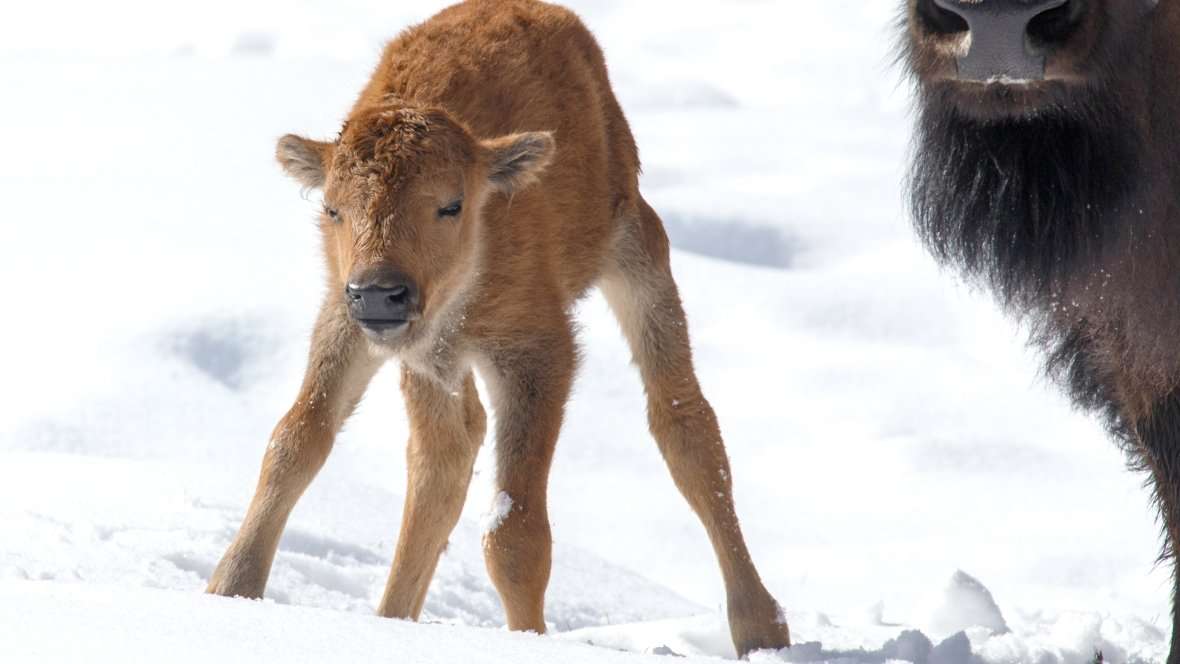Bison recently introduced into Banff's backcountry are settling into their new homes by welcoming new offspring to the herd.
Parks Canada says it's the first time wild bison calves have been born in Banff's backcountry in 140 years.
The first calf was born on Earth Day last weekend, and two more tiny bison have joined the herd since. Parks Canada expects seven more calves to follow soon.
"It's fantastic. We knew it was coming, but when the message came out of the backcountry on Saturday that the first calf had already dropped, I think everyone was pleasantly surprised," said Bill Hunt, a resource conservation manager with Parks Canada.
"It's a really key step, and the fact that these young calves look so healthy and so well adjusted in this habitat is really encouraging."
Known as red coats, the baby bison are currently sticking close to their mothers — who can be quite assertive, Hunt said.
The male bison seem to be curious, but are keeping their distance. Hunt said grizzly bears have been known to seek out elk calves, but the current paddock that the bison call home offers some protection from predators.
The calves are expected to become more playful in the near future, but are currently enjoying the fresh snowfall in the Banff area.
The reintroduction of a wild bison population back in the park is part of Canada's 150th anniversary celebrations. (Adam Zier-Vogel/Parks Canada)
Officials also hope that the calving bison will help tether the plains animals to the area.
"It's a huge step in this process," said Hunt. "We know … that where a young female drops her calf it really ties her to that space even if she was born somewhere else."
While many remember what Parks Canada calls a "display herd" of bison housed in a paddock near the Banff townsite until 1997, this new herd represents a return to wild animals.
In February, 16 bison — 10 pregnant cows and six males — were loaded onto shipping containers on trucks in Elk Island National Park, about 35 kilometres east of Edmonton.
The shipping containers were ferried by helicopter to an enclosed pasture in Panther Valley near Sundre on the eastern slopes of the park.
Bison helicoptered in to Banff for historic homecoming after 140 years0:35
The bison are being monitored by Parks Canada using radio collars.
"We've been giving them lots of space," said Hunt. "The staff are watching from quite a distance using spotting scopes and things like that so to make sure we don't bother them."
In the summer of 2018 — after another calving season — they'll be released into a 1,200-square-kilometre area on the eastern slopes of the park.
Parks Canada says they will then be able to interact with other native species, forage for food and integrate into the ecosystem.
The new herd could eventually roam free in the national park west of Calgary after the initial five-year pilot is over and results of the project are evaluated. Parks Canada is monitoring how the herd affects water quality and wildlife such as songbirds and other ungulates like elk.
Officials hope the herd will grow to roughly 80 bison by the end of the pilot project.
The historic homecoming is part of Canada's 150th anniversary celebrations with a goal of re-establishing Indigenous connections to the bison and park.
If the herd becomes too big, Parks Canada will work with local First Nations to cull the herd, Hunt said.

AltusHumanitas on April 26th, 2017 at 06:52 UTC »
A wild animal is born after 140 years and people are complaining that bison are not cuddleable. lel.
TheInverseKey on April 26th, 2017 at 05:13 UTC »
It's a great day for Canada and therefore the world!
gaplant-tr5 on April 26th, 2017 at 02:58 UTC »
its a shame bison are so defensive and dangerous to be around. Both the calves and the adults look extremely pettable.
Moose = same problem